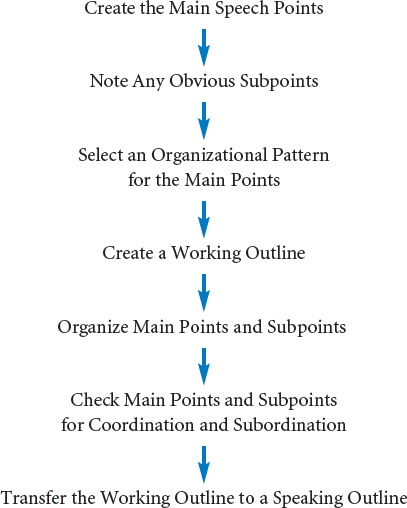Plan on Creating Two Outlines
As you develop a speech, you will actually create two outlines: a working outline (also called a preparation or rough outline) and a speaking, or delivery outline. The purpose of the working outline is to organize and firm up main points and, using the research you’ve gathered, to develop supporting points to substantiate them. Completed, the working outline should contain your entire speech, organized and supported to your satisfaction.
The speaking outline is the one you will use when you are practicing and actually presenting the speech. Speaking outlines, which contain your ideas in condensed form, are much briefer than working outlines. Figure 13.1 provides an overview of the steps involved in outlining a speech.
Before taking a closer look at the working outline, consider the three types of wording formats speakers use to outline speeches.
Use Sentences, Phrases, or Key Words
Speeches can be outlined in complete sentences, phrases, or key words.
The Sentence Outline Format
In the sentence outline format, each main and supporting point is stated in sentence form as a declarative sentence (e.g., one that makes a statement or assertion about something). Often, these sentences are stated in much the same way the speaker wants to express the idea during delivery. Working outlines typically contain sentences, reflecting much if not all of the text of the speech. The following is an excerpt in sentence format from a speech by Mark B. McClellan on keeping prescription drugs safe:2
- The prescription drug supply is under unprecedented attack from a variety of increasingly sophisticated threats.
- Technologies for counterfeiting—ranging from pill molding to dyes—have improved across the board.
- Inadequately regulated Internet sites have become major portals for unsafe and illegal drugs.

The Phrase Outline Format
A phrase outline uses partial construction of the sentence form of each point. Phrase outlines encourage you to become so familiar with the speech that a glance at a few words is enough to remind you of exactly what to say. McClellan’s sentence outline would appear as follows in phrase form:
- Drug supply under attack
- Counterfeiting technologies more sophisticated
- Unregulated Internet sites
The Key-Word Outline Format
The key-word outline uses the smallest possible units of understanding to outline the main and supporting points. In this format, each speech point contains just a few cue words to spur your memory.
A section of McClellan’s outline would appear as follows in key-word outline form:
- Threats
- Counterfeiting
- Internet
Use a Key-Word Outline for Optimal Eye Contact
The type of outline you select will affect how well you deliver the speech. The less you rely on your outline notes, the more eye contact you can have with audience members, and eye contact is an essential aspect of a successful speech. For this reason, many speaking experts recommend using key-word or phrase outlines over sentence outlines for delivery, with the more succinct key-word outline often being the preferred format. Key-word outlines permit not only the greatest degree of eye contact but also greater freedom of movement and better control of your thoughts and actions than either sentence or phrase outlines. With sufficient practice, the key words will jog your memory so that the delivery of your ideas becomes more natural.
If there are points in your speech where you want to note exact quotations or precisely state complicated facts or figures, you can write those out in full sentences within the key-word outline. Sentences may help under the following conditions:
- When the issue is highly controversial or emotion-laden for listeners and precise wording is needed to make the point as clear as possible
- When the material is highly technical and exact sentence structure is critical to an accurate representation of the material
- When a good deal of material relies on quotations and facts from another source that must be conveyed precisely as worded
Even with the inclusion of an occasional sentence, if at any time during the speech you experience stage fright or a lapse in memory, a key-word outline may not be of much help. This is why preparation is essential when using one. You must be confident in knowing the topic and the speech arrangement well enough to deliver the speech extemporaneously. An extemporaneous speech is carefully planned and practiced in advance and then delivered from a key-word or phrase outline (see Chapter 17). (Remember that outlining requirements differ among instructors. Be sure to understand your instructor’s specific outlining and formatting requirements before you begin outlining your speech.)